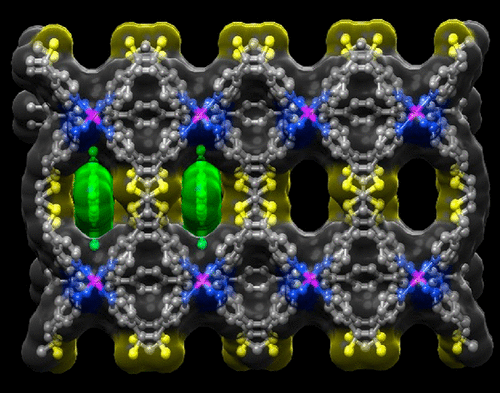当前位置:
X-MOL 学术
›
Inorg. Chem.
›
论文详情
Our official English website, www.x-mol.net, welcomes your
feedback! (Note: you will need to create a separate account there.)
Concomitant Use of Tetrathiafulvalene and 7,7,8,8-Tetracyanoquinodimethane within the Skeletons of Metal–Organic Frameworks: Structures, Magnetism, and Electrochemistry
Inorganic Chemistry ( IF 4.3 ) Pub Date : 2019-06-12 00:00:00 , DOI: 10.1021/acs.inorgchem.9b01000 Hai-Ying Wang 1, 2 , Jian Su 2 , Jian-Ping Ma 3 , Fei Yu 2 , Chanel F. Leong 4 , Deanna M. D’Alessandro 4 , Mohamedally Kurmoo 5 , Jing-Lin Zuo 2
Inorganic Chemistry ( IF 4.3 ) Pub Date : 2019-06-12 00:00:00 , DOI: 10.1021/acs.inorgchem.9b01000 Hai-Ying Wang 1, 2 , Jian Su 2 , Jian-Ping Ma 3 , Fei Yu 2 , Chanel F. Leong 4 , Deanna M. D’Alessandro 4 , Mohamedally Kurmoo 5 , Jing-Lin Zuo 2
Affiliation

|
In search of multifunctional metal–organic frameworks (MOFs), redox-active donors and acceptors, namely, tetrathiafulvalene (TTF) and 7,7,8,8-tetracyanoquinodimethane (TCNQ), were concomitantly used as skeletal components with diamagnetic metal nodes (Cd and Zn) to construct unique framework materials. Six isostructural frameworks were synthesized by diffusion of metal salts, TTF(py)4, and either paramagnetic Li(TCNQ) or diamagnetic H2TCNQ. They were characterized by single-crystal X-ray diffraction and FT-IR and UV–vis–NIR spectroscopy, and their physical properties were studied, including two postsynthetic modifications involving crystal-to-crystal transformations following a solid-solution reaction with I2. The highly colored crystals of two isostructural Zn and Cd frameworks contain undulating Cd-TTF(py)4 layers entwined with TCNQ in a chicken-wire net as part of the skeleton of the MOF as well as TCNQ intercalated within the channels, while nitrate anions are occluded within the cavities formed by the pyridine moieties. Reaction with I2 replaces each intercalated TCNQ•– within the channels with I3–. The optical properties and the electron paramagnetic resonance (EPR) spectra indicate the presence of only radical TCNQ•– in the parent compounds, while the magnetic susceptibilities enabled an estimation of the amount of TCNQ•– (S = 1/2) leading to almost paramagnetic behavior. Solid-state electrochemistry provides evidence of several one-electron redox states corresponding to the electroactive cores.
中文翻译:

在金属-有机骨架的骨架中并用四硫富瓦烯和7,7,8,8-四甲基氨基喹二甲烷:结构,磁性和电化学
为了寻找多功能的金属有机框架(MOF),氧化还原活性的供体和受体,即四硫富瓦烯(TTF)和7,7,8,8-四氰基喹二甲烷(TCNQ),被同时用作具有抗磁性金属节点的骨架成分( Cd和Zn)来构造独特的骨架材料。通过金属盐,TTF(py)4和顺磁性Li(TCNQ)或反磁性H 2 TCNQ的扩散合成了六个同构框架。它们通过单晶X射线衍射,FT-IR和UV-vis-NIR光谱进行表征,并对其物理性质进行了研究,包括与I 2固溶反应后涉及晶体到晶体转变的两个后合成修饰。。两个等结构的Zn和Cd骨架的高度着色晶体包含起伏的Cd-TTF(py)4层,该层与TCNQ缠绕在金属丝网中,作为MOF骨架的一部分,TCNQ嵌入通道中,而硝酸根阴离子被吡啶部分形成的腔内的β1-β2闭塞。反应与我2个替换每个闰TCNQ • -在通道内与我3 - 。光学性质和电子顺磁共振(EPR)光谱表明,母体化合物中仅存在自由基TCNQ •,而磁化率可以估算TCNQ •的量(S= 1/2)导致几乎顺磁的行为。固态电化学提供了与电活性核相对应的几种单电子氧化还原态的证据。
更新日期:2019-06-12
中文翻译:

在金属-有机骨架的骨架中并用四硫富瓦烯和7,7,8,8-四甲基氨基喹二甲烷:结构,磁性和电化学
为了寻找多功能的金属有机框架(MOF),氧化还原活性的供体和受体,即四硫富瓦烯(TTF)和7,7,8,8-四氰基喹二甲烷(TCNQ),被同时用作具有抗磁性金属节点的骨架成分( Cd和Zn)来构造独特的骨架材料。通过金属盐,TTF(py)4和顺磁性Li(TCNQ)或反磁性H 2 TCNQ的扩散合成了六个同构框架。它们通过单晶X射线衍射,FT-IR和UV-vis-NIR光谱进行表征,并对其物理性质进行了研究,包括与I 2固溶反应后涉及晶体到晶体转变的两个后合成修饰。。两个等结构的Zn和Cd骨架的高度着色晶体包含起伏的Cd-TTF(py)4层,该层与TCNQ缠绕在金属丝网中,作为MOF骨架的一部分,TCNQ嵌入通道中,而硝酸根阴离子被吡啶部分形成的腔内的β1-β2闭塞。反应与我2个替换每个闰TCNQ • -在通道内与我3 - 。光学性质和电子顺磁共振(EPR)光谱表明,母体化合物中仅存在自由基TCNQ •,而磁化率可以估算TCNQ •的量(S= 1/2)导致几乎顺磁的行为。固态电化学提供了与电活性核相对应的几种单电子氧化还原态的证据。

































 京公网安备 11010802027423号
京公网安备 11010802027423号